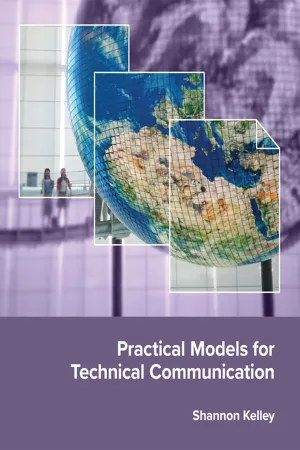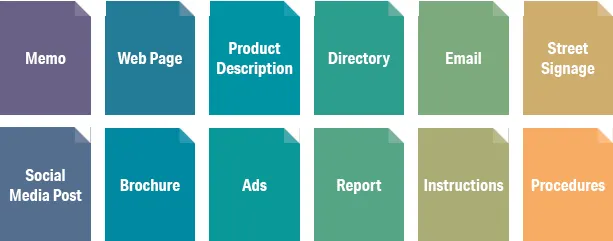
- 398 pages
- English
- ePUB (mobile friendly)
- Available on iOS & Android
eBook - ePub
Practical Models for Technical Communication
About this book
Practical Models of Technical Communication is a college-level textbook for technical writers and communicators. Written in plain and accessible language, this textbook is designed to provide students with solid tools, useful models, interesting scenarios, and a vocabulary of technical terms that will allow them to communicate effectively as part of a fast-paced, global workforce. Its approachable, real-world examples and detailed visuals guide students in creating multimodal, technical documents that reach a broad audience.
This book explores the fundamentals of technical communication, expanding on the following topics:
• Writing and organizing an array of technical documents such as definitions, descriptions, instructions, procedures, proposals, and reports
• Embracing ethical communication visually and in writing
• Designing documents for readability, emphasis, and organization
• Increasing rhetorical awareness of multimodality in all types of communication
• Researching and documenting source material effectively
• Crafting successful job materials for entering the workforce
• Communicating professionally within various work environments
• Navigating the changing needs of audiences that technical writers meet along the way
This book explores the fundamentals of technical communication, expanding on the following topics:
• Writing and organizing an array of technical documents such as definitions, descriptions, instructions, procedures, proposals, and reports
• Embracing ethical communication visually and in writing
• Designing documents for readability, emphasis, and organization
• Increasing rhetorical awareness of multimodality in all types of communication
• Researching and documenting source material effectively
• Crafting successful job materials for entering the workforce
• Communicating professionally within various work environments
• Navigating the changing needs of audiences that technical writers meet along the way
Frequently asked questions
Yes, you can cancel anytime from the Subscription tab in your account settings on the Perlego website. Your subscription will stay active until the end of your current billing period. Learn how to cancel your subscription.
No, books cannot be downloaded as external files, such as PDFs, for use outside of Perlego. However, you can download books within the Perlego app for offline reading on mobile or tablet. Learn more here.
Perlego offers two plans: Essential and Complete
- Essential is ideal for learners and professionals who enjoy exploring a wide range of subjects. Access the Essential Library with 800,000+ trusted titles and best-sellers across business, personal growth, and the humanities. Includes unlimited reading time and Standard Read Aloud voice.
- Complete: Perfect for advanced learners and researchers needing full, unrestricted access. Unlock 1.4M+ books across hundreds of subjects, including academic and specialized titles. The Complete Plan also includes advanced features like Premium Read Aloud and Research Assistant.
We are an online textbook subscription service, where you can get access to an entire online library for less than the price of a single book per month. With over 1 million books across 1000+ topics, we’ve got you covered! Learn more here.
Look out for the read-aloud symbol on your next book to see if you can listen to it. The read-aloud tool reads text aloud for you, highlighting the text as it is being read. You can pause it, speed it up and slow it down. Learn more here.
Yes! You can use the Perlego app on both iOS or Android devices to read anytime, anywhere — even offline. Perfect for commutes or when you’re on the go.
Please note we cannot support devices running on iOS 13 and Android 7 or earlier. Learn more about using the app.
Please note we cannot support devices running on iOS 13 and Android 7 or earlier. Learn more about using the app.
Yes, you can access Practical Models for Technical Communication by Shannon Kelley in PDF and/or ePUB format. We have over one million books available in our catalogue for you to explore.
Information
eBook ISBN
9781943536962Subtopic
Computer Science General
Chapter 1
Technical Communication Fundamentals
Abstract: Welcome to technical communication. Each chapter begins with an abstract that models concise writing and prepares you for the content to come. As you’ll learn in this book, technical communication is a journey from problem to solution. The technical communicator must use and arrange clear, concise, precise, and accurate information to create successful, user-friendly documents. Different media, such as images or videos, often help make this information understandable. The key is to know the material’s purpose and its audience, called the “user” in this book, and choose the best form for the message. If users can solve their problems or accomplish their goals using content you create, they win, you win, and your employer wins. This chapter also introduces you to the Problem-Solution Framework that will guide your choices as you become a more proficient technical communicator.
Looking Ahead
1. Why Technical Communication Matters
2. The Problem-Solution Framework
3. Purposeful Communication
4. Characteristics of Technical Communication
5. Creating User-Friendly Content
Key Terms
» accuracy
» audience
» clarity
» client
» conciseness
» data
» demographics
» end user
» fact
» inference
» judgment
» medium, media
» message
» mode
» multimedia/multimodal communication
» precision
» Problem-Solution Framework
» purpose
» scanning
» skimming
» technical communication
» technical document
» user profile
Why Technical Communication Matters
Have you ever tried to explain to someone how to tie their shoes? It’s much harder than it seems. You’ve been tying your own shoes since kindergarten and now can do it without thinking. In order to show someone else how to do it, however, you have to take what has become automatic and break it down into small steps in a specific order. This process takes mental dexterity. You have to imagine yourself in someone else’s place to be able to teach them how to tie their shoes. If you do your job well, you help them build a new skill and prevent them from tripping over untied laces. Shoe tying and technical communication may seem like two very different activities, but we offer this analogy to help you understand your role as a technical communicator.
Technical communicators help audiences solve problems and break complex topics down into simple steps. That’s why you’re reading this book. In the pages that follow, you will learn how technical communication shares similarities with the shoe-tying situation. The ability to explain with clarity is crucial on the job, whether you work for a government think tank, an engineering firm, or a preschool. What’s more, you can apply these skills at any stage in your professional development.
You might be nervous about a course in technical communication because you think the word “technical” implies learning complicated and tedious material. You might have avoided or postponed taking a course in technical communication, assuming that the skills aren’t necessary for your chosen field. This textbook aims to show you that technical communication isn’t hyper-specialized, impractical, or intimidating. Think about your field. Training to be a professional means you are training how to be a problem solver. Technical communication is about communicating the most direct and effective path toward a solution. Employers and organizations tackle issues, and they need people with advanced communication skills who can translate ideas into plain English.
Figure 1.1. Types of Technical Documents. Technical documents take many forms. The common denominator in technical communication is the creation of content to meet a specific need and produce a desired result for the end user.

Technical Communication Defined
Technical communication involves generating clear, precise, and accurate content about practical information in a field. A technical communicator creates a purposeful message for a specific audience. This can take many forms (figure 1.1).
Although written content is one method used by technical communicators, it’s not the only one. You’ll notice that technical communication is also about formatting, layout, and visual design, not just words on a page. As a result, this book uses the phrase “technical communication” instead of “technical writing.” This textbook introduces you to diverse approaches to technical communication and a range of communication skills that will be useful in any profession.
Technical documents—the content generated by technical communicators—surround you. For example, a bus stop contains specific information relevant to users of public transportation. Riders need to sort through arrival and departure times quickly and efficiently so they don’t miss their bus. Effective design organizes the information: the location of bus stops, the route schedule, and connection points with other bus lines. When a document like this fails to do its job, the consequences are real.
Start noticing where and how technical documents intersect with your life. You’ll begin to see examples everywhere. Store directories, the washing label sewn inside your shirt, heating instructions for a microwave dinner—these are technical documents, too. As simple as these examples sound, they didn’t just happen. Someone thought about you, the user, when they designed the mall kiosk to help you get to that out-of-the-way shop that sells pickle-flavored lip balm. The icons on your favorite shirt’s label tell you at a glance how to wash it so it lasts longer. Dinner is saved—as well as your taste buds—by instructions that tell you to let the microwaved mashed potatoes sit for five minutes before shoveling them into your mouth.
Depending on your field, a technical document may have a different name: deliverable, product, report, text, etc.
Technical communicators are a diverse group. Look around and you’ll see several majors represented in your classroom. You might have classmates studying computer science, engineering, business, education, medicine, or human services. Technical communicators could be teachers who provide student reports for extra instructional assistance, nurses who write detailed patient summaries to ensure continuity of care during shift changes, or engineers who create product or process schemas.
This book teaches you how to solve technical problems by focusing on the following concepts in your writing:
» The audience’s attributes (the “user”)
» The purpose of the document
» The message that will resolve the problem
Effective technical communication involves creativity, discipline, and resourcefulness. Wherever you might be headed after this, you are responsible for using the tools described in this book to make someone’s life easier and, sometimes, safer.
The Problem-Solution Framework
In an ideal world, technical communicators wouldn’t be necessary. Instead, everyone would work through their daily tasks without encountering problems. That ideal world doesn’t exist, unfortunately. Individuals often encounter obstacles—complex technical problems—that prevent them from completing tasks. Most users need outside help to move beyond these obstacles.
This is where a technical communicator comes in. Technical communicators can use the Problem-Solution Framework to develop a solution in the form of a technical document. When technical communicators consider purpose and audience, they craft a solution in the form of a message (figure 1.2...
Table of contents
- Cover
- Title Page
- Copyright
- Contents
- Introduction
- Chapter 1: Technical Communication Fundamentals
- Chapter 2: Technical Communication Ethics
- Chapter 3: Layout and Design
- Chapter 4: Multimodal and Multimedia Communication
- Chapter 5: Research Methods for Technical Communication
- Chapter 6: Job Materials
- Chapter 7: Workplace Communication
- Chapter 8: Technical Definitions and Descriptions
- Chapter 9: Instructions and Procedures
- Chapter 10: Proposals and Short Reports
- Chapter 11: Formal Reports
- Chapter 12: Make Technical Communication Work for You
- Acknowledgments
- Appendix A: MLA Report
- Glossary Index